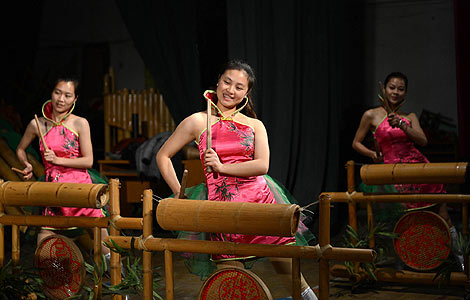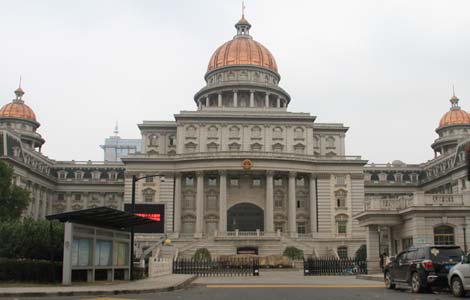
BEIJING - The State Council Information Office unveiled the National Human Rights Action Plan (2012-2015) (hereinafter referred to as the Action Plan) on June 11, drawing wide attention, both domestically and internationally. Wang Chen, director of the International Communication Office of the Communist Party of China (CPC) Central Committee and head of the State Council Information Office, answered questions concerning China's formulation of the Action Plan in an exclusive interview with Xinhua News Agency.
The following is the translated version of the full text of the interview:
Xinhua: The Chinese government introduced the National Human Rights Action Plan (2009-2010) in 2009, and has now unveiled the National Human Rights Action Plan (2012-2015). Why is the formulation of the second Action Plan important?
Wang Chen: Ensuring and enjoying human rights in the broadest sense is a lofty ideal and goal that the Chinese government and people have unswervingly pursued. Respecting and safeguarding human rights is one of this country's constitutional principles and an important guideline of governance for the Chinese government.
The first National Human Rights Action Plan that the Chinese government introduced in 2009 has substantially facilitated the development of the cause of human rights in China, and has been widely acclaimed by the Chinese people and widely praised by the international community. The 2012-2015 period is crucial in terms of implementing the 12th Five-Year Plan for the National Economic and Social Development, deepening reform and opening-up, accelerating the transformation of the economic growth pattern and breaking new ground for scientific development; it is also an important period for enhancing human rights protection and realizing the all-round development of the cause of human rights. Building on the past experience gained in formulating and enforcing the first Action Plan, the Chinese government has formulated the second human rights action plan to specify its aims and tasks in terms of promoting and protecting human rights during the 2012-2015 period.
The formulation of the Action Plan is greatly significant in terms of both consolidating the progress and achievements made in the cause of human rights in China and for continuing to solve existing problems and tackle new challenges; it is of great significance for further improving human rights protection measures in legislation, administration and judicial areas. It is also significant for propelling institutional and legislative protection of human rights, for further firming up the constitutional principle of respecting and safeguarding human rights, and for safeguarding citizens' economic, political, social and cultural rights; it also holds great significance for advancing scientific development and promoting social justice and harmony, for endeavoring to ensure that every member of society lives a more dignified and happier life and for striving to realize the goal of building a moderately prosperous society.
The promulgation of the new National Human Rights Action Plan indicates the Chinese government's determination to further the cause of human rights in China in an all-round way, and also signals that the cause of human rights in China has entered a new stage, which is being advanced in a planned, steady and comprehensive fashion.
Xinhua: The Action Plan covers China's various aspects including economy, politics, society and culture, and is closely related to the work of government departments. It has also attracted the attention of people from all walks of life. Would you please outline how the Action Plan was formulated?
Wang Chen: The Action Plan involved the joint efforts of the relevant departments of the CPC Central Committee and the central government as well as the broad participation of all social sectors. It covers all aspects of Chinese life, including economy, politics, culture and society. In order to establish a good plan and to ensure the authority and effectiveness of the Action Plan, the Chinese government set up a joint meeting mechanism for the National Human Rights Action Plan. The State Council Information Office and the Ministry of Foreign Affairs, two members of the "joint meeting mechanism," took the responsibility of convening meetings. The mechanism included a further 54 departments of the CPC Central Committee and the State as well as people's organizations and non-governmental organizations. Members included: the General Office of the Standing Committee of the National People's Congress (NPC), the Commission for Legislative Affairs of the NPC Standing Committee, the General Office of the National Committee of the Chinese People's Political Consultative Conference (CPPCC), the Social and Legal Affairs Committee of the CPPCC National Committee, the Supreme People's Court, the Supreme People's Procuratorate, the Organization Department of the CPC Central Committee, the Publicity Department of the CPC Central Committee, the United Front Work Department of the CPC Central Committee, the International Department of the CPC Central Committee, the Policy Research Office of the CPC Central Committee, the National Development and Reform Commission, the Ministry of Education, the Ministry of Science and Technology, the Ministry of Industry and Information Technology, the State Ethnic Affairs Commission, the Ministry of Public Security, the Ministry of Supervision, the Ministry of Civil Affairs, the Ministry of Justice, the Ministry of Finance, the Ministry of Human Resources and Social Security, the Ministry of Land and Resources, the Ministry of Environmental Protection, the Ministry of Housing and Urban-Rural Development, the Ministry of Transport, the Ministry of Railways, the Ministry of Water Resources, the Ministry of Agriculture, the Ministry of Culture, the Ministry of Health, the National Population and Family Planning Commission, the National Audit Office, the General Administration of Quality Supervision, Inspection and Quarantine, the Sate Administration of Radio, Film and Television, the General Administration of Press and Publication, the General Administration of Sport, the State Administration of Work Safety, the National Bureau of Statistics, the State Forestry Administration, the State Intellectual Property Office, the State Administration for Religious Affairs, the Legislative Affairs Office of the State Council, the State Bureau for Letters and Calls, the State Food and Drug Administration, the National Working Committee on Children and Women under the State Council, the State Council Poverty Alleviation Leading Group Office, the National Committee on Ageing, the Food Safety Commission Office of the State Council, the All-China Federation of Trade Unions, the Central Committee of the Communist Youth League, the All-China Women's Federation, the China Disabled Persons' Federation, and the China Society for Human Rights Studies.
Since last September, 56 members of the "joint meeting mechanism" have contributed and, in addition, the State Council Information Office organized the formation of a panel of experts to participate in the drafting and formulation of the plan. Experts were invited from a range of universities and research institutions including Nankai University, Sichuan University, the Chinese Academy of Social Sciences, the Shanghai Academy of Social Sciences, and the Party School of the CPC Central Committee. This year, based on the first draft worked out at the end of last year, we have held numerous joint meetings, seminars and discussions, organized officers in charge, experts and scholars to conduct in-depth investigation and research, and have widely solicited opinions and suggestions from departments, social and non-governmental organizations, universities, research institutions and other social sectors through such means as face-to-face communication and letters. The National Human Rights Action Plan (2012-2015) was finalized after rigorous examination, discussion, revision and improvements. The State Council has approved this Action Plan and authorized the State Council Information Office to promulgate it.







